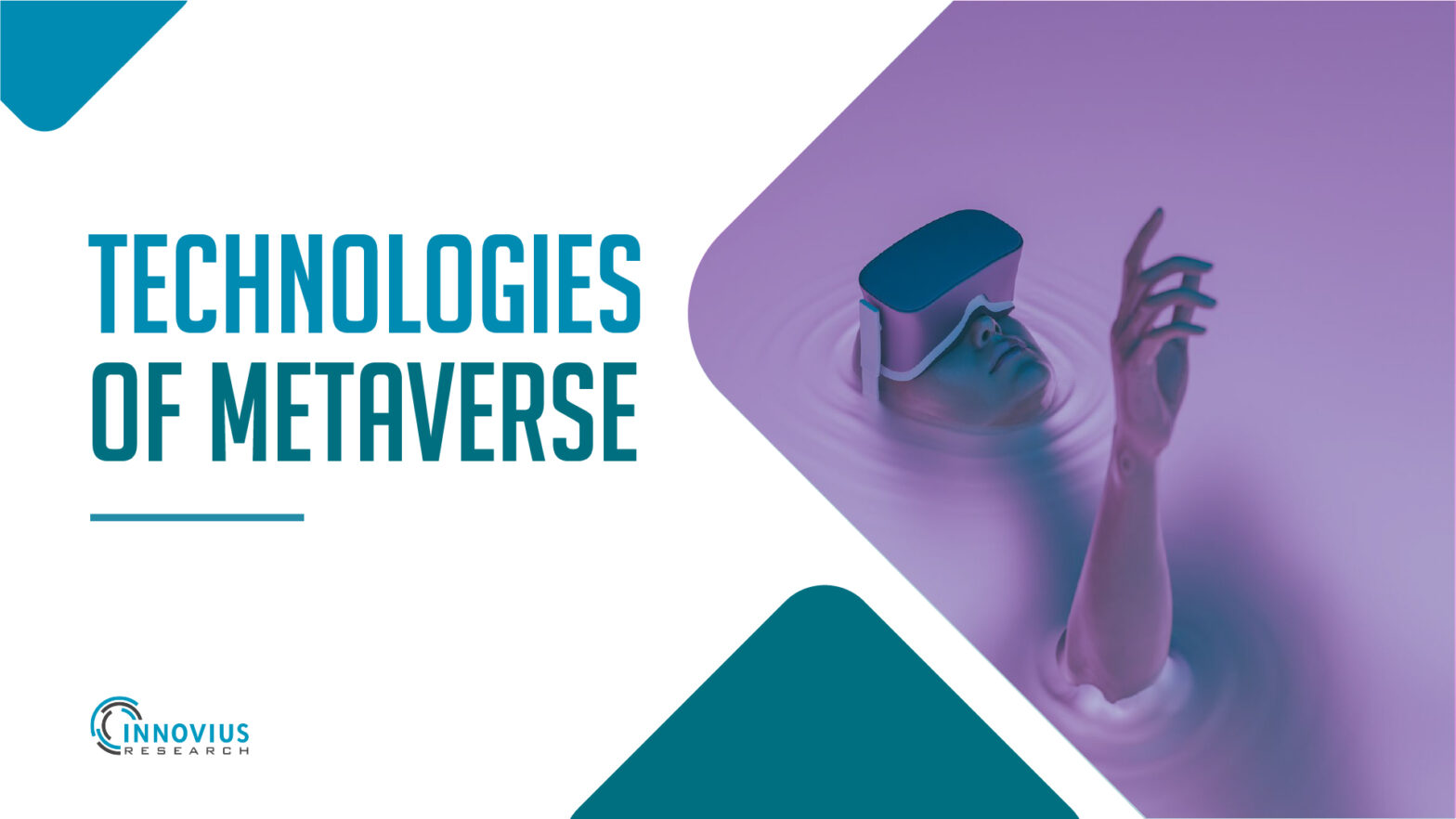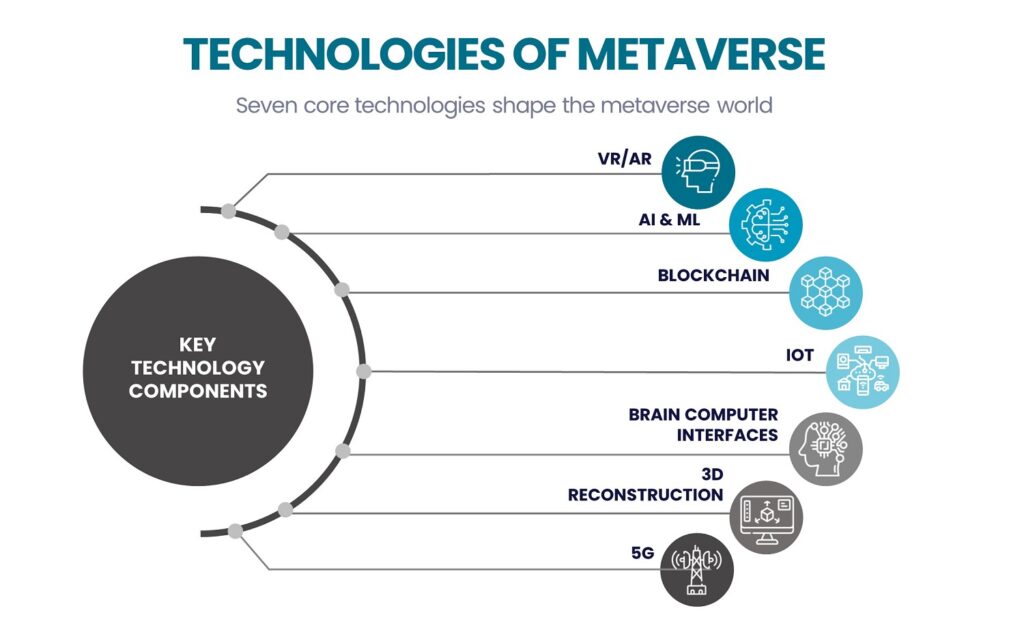
Explore the Technologies of Metaverse
There are seven core technologies that shape the metaverse world.
➥ Technology 1 – Virtual Reality (VR) / Augmented Reality (AR) / Xtended Reality (XR)
➥ Technology 2 – Artificial Intelligence (AI)/ Machine Learning (ML)
➥ Technology 3 – Blockchain
➥ Technology 4 – Internet-of-Things (IoT)
➥ Technology 5 – Brain-Computer Interfaces
➥ Technology 6 – 3D Reconstruction
➥ Technology 7 – 5G

Technology 1: Virtual Reality (VR) / Augmented Reality (AR) / Xtended Reality (XR)
Virtual Reality (VR)
The most well-known Metaverse Technology is Virtual Reality. It is an experience that simulates real-life scenarios. Gaming, social networking, education, and job training are examples of real-world applications. The Metaverse can disrupt different businesses by providing a virtual reality (VR)-based wearables that transfer individuals to another virtual world from the comfort of their own homes.
One example is Facebook Horizons, which allows users to explore virtual worlds where they may interact with people from all around the world, take part in entertaining challenges, and even create their own. It’s a virtual collaboration experience that allows people from all over the world to collaborate in the same virtual room, regardless of their physical location. The Oculus Quest, HTC Vive, Cosmos, Sony, Playstation VR, and Valve index are some of the most well-known VR headsets.
Augmented Reality (AR)
The Metaverse’s primary technology is Augmented Reality, which is an experience in which designers augment aspects of a user’s physical world with computer-generated information. With the use of sophisticated artificial intelligence, AR contact lenses and AR glasses could eventually be utilized to augment the world around users and support virtual assistants.
Users would be able to navigate both the real and virtual worlds with the help of this AI, for instance, users will be able to take a 3D virtual hotel tour and research the location of the hotel they are considering staying at utilizing virtual reality platforms and technology due to the Metaverse. Travelers can put on their 3D digital avatars and take a virtual tour of a hotel room before making a reservation.
eXtended Reality (XR)
eXtended Reality (XR) is a metaverse concept that encompasses Augmented Reality (AR), Virtual Reality (VR), and Mixed Reality (MR). Fortnite, Roblox, and ZEPETO are three well-known Metaverse games that use Extended Reality on flat screens. Extended Reality is used in a variety of industries in addition to gaming.
There are case studies of instructional content that uses AR/VR simulations and tools that integrate AI, location, and translation features, all of which make use of enhanced hardware performance. For many years, the US Army, for example, has employed a virtual reality dome for military training. For training and battle, the army ordered 120,000 HoloLens augmented reality devices.
Technology 2: Artificial Intelligence (AI)/ Machine Learning (ML)
Artificial Intelligence (AI)
In the Metaverse, AI technology can help in the creation of Metaverse assets such as characters, landscapes, buildings, character routines, and more, advanced AI capabilities may be integrated with gaming engines such as Unreal Engine in the future. AI can automate software development processes; enabling users to create increasingly sophisticated Metaverse assets with less and less work. AI may also be used to develop, audit, and safeguard blockchain smart contracts. It will be hard to create an engaging, real, and scalable Metaverse experience without AI. That is why companies like Meta work with think tanks and ethics organizations to mitigate the hazards of AI without limiting its promise.
Metaverse use AI in different forms-
➟ Avatars– Avatar is the Metaverse’s most talked-about and interesting concept. AI can analyze 2D user photos or 3D scans to produce Avatars that are extremely lifelike and precise. AI is already being used to assist in the creation of Avatars for the Metaverse by companies like Ready Player Me.
➟ Digital Human– Digital humans in the Metaverse are 3D chatbots that can react and respond to user activities in a virtual reality setting. It is entirely made of AI technology and is a crucial part of Metaverse’s architecture. In contrast to a character controlled by a user or player, they are non-playing characters (NPCs), who are characters in virtual reality or games whose replies and actions are governed by an automated script or set of rules.
➟ Language Processing – With the use of AI, users will be able to interact in the Metaverse freely. Artificial intelligence can understand natural languages like English and convert them into a machine-readable format. After that, an analysis is carried out, and an output (or response) is generated, which is then transformed back to English and sent to the user.
Technology 3 – Blockchain
The blockchain-based Metaverse allows users to access any digital place without the need for a centralized authority. Blockchain has proven to be effective in six essential metaverse categories such as digital proof of ownership, digital collectibility, value transfer, governance, accessibility, and interoperability. The metaverse is well-suited to blockchain technology because it gives a transparent and cost-effective alternative. In-game assets, virtual currencies, non-fungible tokens (NFTs), self-identity authentication, and real estate are all examples of how blockchain might be used in the Metaverse. Cryptocurrency exists in the metaverse to help with the establishment of a digital economy.
The assets in blockchain games are frequently in the form of cryptocurrencies with the owner verified, such as NFT or crypto tokens, and are stored in the chain in a decentralized form, due to their decentralized and Web3-oriented capabilities. Players have complete control and ownership of the game.
MetaBlaze is a GameFi x Defi utility token that is intended for use in all elements of web3 technology, with a particular focus on the gaming Metaverse. It is the first Blockchain-gaming Metaverse that generates lifelong returns, allowing gamers to gather and immerse themselves in a high-level, 3D, P2E (play-to-earn) RPG (role-playing-game) with exclusive content, and superior graphics, and hyper engaging gameplay.
Technology 4 – Internet-of-Things (IoT)
One of the Metaverse’s IoT applications is to collect and distribute data from the physical world. The Internet of Things (IoT) has the potential to easily connect the 3D environment to a large number of real-world devices. This enables the creation of real-time simulations in the Metaverse. To handle the data it collects, IoT might use AI and machine learning to improve the Metaverse environment even more.
Metaverse will be able to evaluate and interact with the actual world due to the Internet of Things (IoT). Metaverse will also operate as a 3D user interface for IoT devices, allowing for a unique personalized IoT user experience. Both Metaverse and the Internet of Things will assist the world in making data-driven judgments with the least amount of training and mental resources.
Technology 5 – Brain-Computer Interfaces
Brain-Computer Interfaces Technology can lead the Metaverse world as it allows users to control avatars, various objects, and digital transactions with users’ brain signals. The video game and worker productivity markets are expected to be the first to adopt this technology. This technology will not play a significant role in the Metaverse’s early years. However, some early adopters may begin employing brain-computer interfaces to link to the neocortex by the mid-2030s.
The neocortex is a portion of the cerebral cortex of the human brain that is responsible for higher cognitive functions. Brain-computer interface systems, such as Neurable’s VR game Awakening, track brain activity using an electrode-laden headpiece connected to an HTC Vive HMD. The software examines the data to determine what should occur in a game. Neurolink as well as Nextmind, are the most well-known companies.
Technology 6 – 3D Reconstruction
3D reconstruction in metaverse will help buyers look around potential new homes from anywhere and make purchases without even having stepped foot inside. It solves the metaverse’s major challenges by using 3D reconstruction to create realistic and natural-looking environments in a digital environment that seems as near to the real world as possible.
Users can take their environment online by producing accurate 3D photorealistic models of buildings, physical locations, and items using sophisticated 3D cameras. The 3D spatial data and 4K HD pictures are then sent to computers, which process them and create a virtual replica for people to view in the metaverse. These virtual duplicates of real-world objects are also known as digital twins.
Technology 7 – 5G
The Metaverse is the Internet’s next generation, allowing for real-time interactions. The Metaverse would necessitate extraordinarily high internet connections, bandwidth, and latency, especially when the user enters a massive virtual realm with extremely detailed textures and polygon counts.
5G provides exceptionally high millimeter-wave frequencies, opening up possibilities such as VR experiences with the feeling of touch and AR experiences that allow visitors to conduct in-depth discussions with AI characters in real-time. It would also aid with global reaches, such as roaming capabilities and enhanced render level of detail (LOD), as well as easy API bind-in and Developer Platforms.
Data Sources: The Economic Times, Global Newswire, Ericsson makeanapplike.com, Samsung Display Newsroom, Arm, KD Nuggets, and many more
Read more on Metaverse
Must Read

